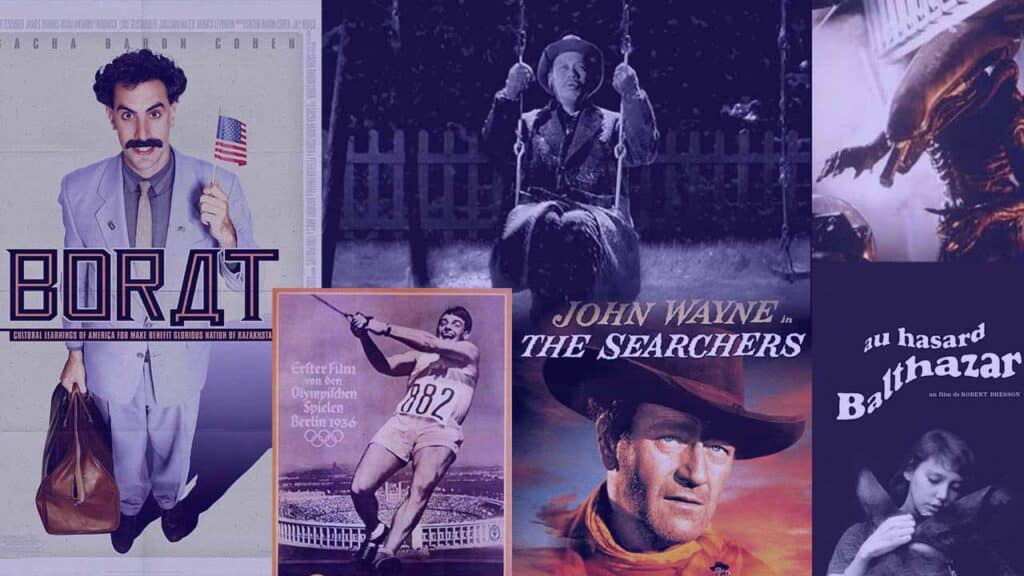Movies can shape our culture, influence our thoughts, and even change the world. Since the birth of cinema, certain films have left an indelible mark on society, challenging norms, sparking conversations, and inspiring action.
In this article, we’ll explore 25 movies that have profoundly impacted our world, examining their cultural significance, societal influence, and lasting legacy.
From groundbreaking technical achievements to influential social commentaries, these films have helped shape history and continue to resonate with audiences today.
1. The Birth of a Nation (1915)
D.W. Griffith’s controversial epic is widely considered the first blockbuster. It revolutionized filmmaking techniques, including innovative camera work and editing. The film’s three-hour runtime, as well as its massive budget of $110,000, was unprecedented at the time. “The Birth of a Nation” introduced techniques such as night photography, fade-outs, and color tinting for dramatic effect.
However, its racist content sparked nationwide protests and led to the revival of the Ku Klux Klan. The portrayal of African Americans in the movie, which featured white actors wearing blackface, reinforced negative stereotypes and praised the Ku Klux Klan as heroes. This led to protests by the NAACP and riots in several cities where the film was shown.
The film demonstrated the power of cinema to shape public opinion and ignite social movements, for better or worse. It also established the feature film as a viable commercial medium and helped create the Hollywood studio system.
2. Battleship Potemkin (1925)
Sergei Eisenstein’s silent Soviet film introduced revolutionary editing techniques, particularly the concept of montage. The famous Odessa Steps sequence, which depicts Tsarist soldiers massacring civilians, has been referenced and parodied countless times in popular culture.
Eisenstein’s theory of montage, which involved juxtaposing contrasting shots to create meaning, became a fundamental principle of film editing. The film’s dynamic editing style created a sense of urgency and emotion that was unprecedented at the time.
“Battleship Potemkin” was commissioned as a propaganda film to commemorate the 1905 Russian Revolution, showcasing cinema’s potential as a tool for political messaging. Despite being banned in many countries for its revolutionary content, the film’s artistic merits transcended its political origins, influencing filmmakers worldwide.
3. Triumph of the Will (1935)
Leni Riefenstahl’s Nazi propaganda film remains a chilling example of cinema’s power to manipulate emotions and spread ideology. The film documents the 1934 Nazi Party Congress in Nuremberg, presenting a carefully choreographed image of Nazi power and unity.
Riefenstahl’s innovative cinematography and editing techniques created a visually stunning work that was undeniably influential from a purely technical standpoint. The film employed creative camera angles, aerial shots, and moving camera platforms to create a sense of dynamism and grandeur.
However, the film’s artistic merits are inseparable from its abhorrent Nazi ideology, making it a subject of ongoing debate in film studies. “Triumph of the Will” is a powerful reminder of how skillful filmmaking can be used to promote destructive ideologies.
4. Citizen Kane (1941)
Orson Welles’ masterpiece revolutionized cinematography, narrative structure, and sound design. It’s often cited as the most excellent film ever made and has influenced countless filmmakers. Welles, who co-wrote, directed, produced, and starred in the movie at 25, brought a fresh, innovative approach to filmmaking.
“Citizen Kane” is renowned for its groundbreaking cinematography, including deep focus, which allows everything in the frame, from foreground to background, to be in focus simultaneously. The film’s non-linear narrative structure was revolutionary for its time, using flashbacks and multiple perspectives to tell the story of Charles Foster Kane.
The film’s use of sound was equally innovative, with overlapping dialogue and creative audio transitions that were uncommon in 1940s Hollywood. Its exploration of media manipulation and the nature of truth feels particularly relevant in our current era of “fake news” and media consolidation.
5. Casablanca (1942)
This timeless romance, set against the backdrop of World War II has become a cultural touchstone. Its quotable dialogue and themes of sacrifice and duty resonated with wartime audiences and continue to captivate viewers today.
“Casablanca” was produced during World War II and released shortly after the Allied invasion of North Africa. Its plot, involving refugees trying to escape to America, reflected the real-life experiences of many Europeans fleeing Nazi occupation.
The film’s production was rushed due to the uncertain political climate of the time, yet it resulted in a masterpiece that has stood the test of time. Casablanca” won three Academy Awards, including Best Picture, and has consistently ranked among the greatest films ever made.
6. The Best Years of Our Lives (1946)
William Wyler’s post-World War II drama was one of the first films to address the challenges faced by returning veterans. It helped shape public understanding of PTSD and the difficulties of reintegration into civilian life.
The film follows three service members as they struggle to readjust to civilian life, dealing with issues such as PTSD, disability, and changing family dynamics. It was groundbreaking in its realistic portrayal of the psychological and social problems faced by veterans at a time when such topics were rarely discussed openly.
The Best Years of Our Lives” was a critical and commercial success, winning seven Academy Awards, including Best Picture. Its success demonstrated that audiences were ready for more mature, complex storytelling that reflected their real-life experiences.
7. Bicycle Thieves (1948)
Vittorio De Sica’s neorealist masterpiece brought attention to the plight of working-class Italians in post-war Rome. Its use of non-professional actors and on-location shooting influenced filmmakers worldwide and helped establish Italian cinema’s global reputation.
The film tells the simple yet devastating story of Antonio, a poor father in Rome who needs his bicycle for a desperately needed job. When the bike is stolen, Antonio and his young son Bruno embark on a heart-wrenching search across the city.
“Bicycle Thieves” is noted for its emotional impact, achieved not through melodrama but through the stark simplicity of its story and the genuine performances of its cast. Its success helped establish Italian cinema’s global reputation and paved the way for other Neorealist masterpieces.
8. Rashomon (1950)
Akira Kurosawa’s groundbreaking film introduced the concept of multiple conflicting narratives to cinema. Its exploration of the subjective nature of truth has influenced storytelling across various media and even given its name to the “Rashomon effect” in psychology.
The film tells the story of murder and rape from four different perspectives, each contradicting the others, challenging the very notion of objective truth. Set in 8th-century Japan, the film’s innovative structure was unlike anything audiences had seen before.
Rashomon” won numerous awards, including the Golden Lion at the Venice Film Festival and an Honorary Academy Award, helping to introduce Western audiences to Japanese cinema. Its impact on world cinema was profound, influencing filmmakers across the globe and paving the way for the international recognition of other Japanese directors.
9. On the Waterfront (1954)
Elia Kazan’s powerful drama about union corruption starred Marlon Brando in a career-defining role. The film’s exploration of loyalty, corruption, and redemption resonated with audiences during the McCarthy era and beyond.
Brando’s portrayal of Terry Malloy is considered one of the most outstanding performances in film history, showcasing his Method acting technique. The film’s famous “I could have been a contender” scene has become one of the most iconic moments in cinema.
“On the Waterfront” won eight Academy Awards, including Best Picture, Best Actor for Brando, and Best Director for Kazan. Many saw its stance on informing as Kazan’s justification for his testimony before the House Un-American Activities Committee, adding another layer of complexity to its legacy.
10. The Seven Samurai (1954)
Another Kurosawa masterpiece, this epic tale of samurai defending a village, has been remade and referenced countless times. Its influence extends beyond cinema to television, literature, and even video games.
At three and a half hours, the film was unprecedented in its scope and attention to detail, setting a new standard for epic storytelling in cinema. Kurosawa’s meticulous approach to filmmaking is evident in every frame, from the carefully choreographed action sequences to the nuanced character development.
“The Seven Samurai” is notable for its innovative use of cinematography, including telephoto lenses and multiple cameras to capture action scenes from various angles. Its structure, which dedicates significant time to the recruitment and preparation of the samurai, has been widely copied in both Eastern and Western cinema.
11. Rebel Without a Cause (1955)
James Dean’s iconic performance captured the essence of teenage rebellion and angst. The film addressed juvenile delinquency and generational conflict, helping to establish the “teenager” as a distinct cultural category.
Released shortly after Dean’s tragic death in a car accident, the film gained additional poignancy and helped cement Dean’s status as a cultural icon. “Rebel Without a Cause” was groundbreaking in its sympathetic portrayal of teenage characters, treating their emotional struggles with seriousness and depth.
The film’s critique of suburban conformity and the emptiness of material success challenged the complacent narrative of 1950s America. It played a significant role in establishing the teenager as a distinct cultural category, influencing fashion, music, and attitudes.
12. Psycho (1960)
Alfred Hitchcock’s psychological thriller revolutionized the horror genre and pushed the boundaries of what was acceptable in mainstream cinema. Its infamous shower scene has become one of the most recognized sequences in film history.
Psycho” is famous for its shocking plot twists and innovative storytelling techniques, particularly the decision to kill off the main character halfway through the film. Hitchcock’s masterful direction creates an atmosphere of unease and suspense that keeps viewers on the edge of their seats throughout the film.
The film’s success paved the way for more graphic and psychologically complex horror films, influencing the development of the slasher genre and psychological thrillers. Its marketing campaign, which insisted that viewers see the film from the beginning, changed how movies were promoted and viewed in theaters.
13. To Kill a Mockingbird (1962)
Based on Harper Lee’s Pulitzer Prize-winning novel, this film brought issues of racial injustice to the forefront of American consciousness. Its portrayal of lawyer Atticus Finch has inspired generations of legal professionals.
Gregory Peck’s portrayal of Atticus Finch is considered one of the most fantastic performances in film history, embodying the character’s unwavering moral integrity and compassion. The film’s depiction of racial injustice in the Jim Crow South was groundbreaking for its time, contributing to the national conversation on civil rights.
“To Kill a Mockingbird” continues to be widely taught in schools, alongside the novel, as a tool for discussing issues of racism, justice, and moral courage. Its enduring popularity and critical acclaim demonstrate its timeless appeal and the universal relevance of its themes.
14. Dr. Strangelove (1964)
Stanley Kubrick’s dark comedy satirized Cold War politics and the threat of nuclear annihilation. Its absurdist humor helped audiences grapple with the genuine fear of global destruction.
The film’s full title, “Dr. Strangelove or How I Learned to Stop Worrying and Love the Bomb,” encapsulates its satirical approach to the deadly serious subject of nuclear war. Kubrick’s decision to treat the material as comedy was controversial but effectively highlighted the absurdity of mutually assured destruction.
Peter Sellers’s multiple roles in the film, including the titular Dr. Strangelove, showcase his incredible range as an actor and add to the film’s surreal quality. The film’s influence can be seen in numerous subsequent works that use humor to address serious political issues.
15. The Graduate (1967)
Mike Nichols’ coming-of-age story captured the generational divide of the 1960s. Its themes of alienation and uncertainty resonated with young audiences and helped usher in a new era of American filmmaking.
The film’s protagonist, Benjamin Braddock, became an icon of youthful disillusionment and rebellion against societal expectations. Its famous ending, with Benjamin and Elaine sitting silently on a bus after disrupting her wedding, perfectly encapsulates the film’s themes of uncertainty and defiance.
“The Graduate” was groundbreaking in its use of popular music, notably Simon & Garfunkel’s soundtrack, which became integral to the film’s mood and themes. Its success helped establish the importance of carefully curated soundtracks in films.
16. 2001: A Space Odyssey (1968)
Kubrick’s science fiction epic set new standards for special effects and challenged audiences with its philosophical themes. Its influence can be seen in countless sci-fi films, and its future vision continues to captivate viewers.
The film’s groundbreaking visual effects, created without computer-generated imagery, set a new standard for realism in science fiction cinema. Its depiction of space travel and future technology was based on careful research and consultation with experts, including NASA scientists.
“2001: A Space Odyssey” is famous for its ambiguous narrative and open-ended conclusion, which have sparked decades of discussion and interpretation. Its exploration of themes such as human evolution, artificial intelligence, and the nature of consciousness continues to resonate with audiences.
17. Easy Rider (1969)
Dennis Hopper’s counterculture road movie helped usher in the New Hollywood era of filmmaking. Its exploration of freedom, conformity, and the American Dream reflected the social upheaval of the late 1960s.
The film’s low-budget, independent production and massive commercial success helped pave the way for a new generation of filmmakers in Hollywood. Its use of a rock music soundtrack, unconventional narrative structure, and frank depiction of drug use were groundbreaking for the time.
“Easy Rider” captured the spirit of the 1960s counterculture but also portrayed the darker side of the era, including violence and intolerance. Its tragic ending reflected the disillusionment and uncertainty of the decade’s end.
18. The Godfather (1972)
Francis Ford Coppola’s mafia epic redefined the gangster genre and is regarded as one of the greatest films ever made. Its exploration of power, family, and the dark side of the American Dream has influenced popular culture for decades.
The film’s portrayal of the Corleone family and the world of organized crime was unprecedented in depth and complexity. It humanized its criminal characters without glorifying their actions, creating a morally ambiguous narrative that challenged viewers.
“The Godfather” was a massive commercial and critical success, winning three Academy Awards, including Best Picture. Its influence can be seen in countless subsequent films and television shows dealing with organized crime and family dynamics.
19. Jaws (1975)
Steven Spielberg’s thriller about a man-eating shark created the modern summer blockbuster. Its success changed Hollywood’s business model and ushered in a new era of high-concept, widely marketed films.
The film’s innovative marketing campaign, including nationwide release and heavy television advertising, set a new standard for promoting and distributing movies. Its success established Spielberg as a prominent director and helped create the template for the modern blockbuster.
“Jaws” is famous for its suspenseful storytelling and iconic score by John Williams. The mechanical difficulties with the shark prop led Spielberg to keep it off-screen for much of the film, inadvertently creating a more suspenseful and compelling thriller.
20. Star Wars (1977)
George Lucas’ space opera revolutionized special effects and merchandising in the film industry. It spawned one of the most successful franchises in history and has had an immeasurable impact on popular culture.
The film’s groundbreaking visual effects, created by Industrial Light & Magic, set a new standard for what was possible in cinema. Its use of archetypal characters and mythological storytelling structures gave it a timeless quality that has contributed to its enduring popularity.
“Star Wars” created a new model for film franchises and merchandising, with toys, books, and other products becoming a significant part of its cultural impact. Its success led to a series of sequels, prequels, and spin-offs that continue to be produced today.
21. E.T. the Extra-Terrestrial (1982)
Spielberg’s heartwarming tale of friendship between a boy and an alien captured the imagination of audiences worldwide. Upon its release, it became the highest-grossing film of all time and cemented Spielberg’s status as a master storyteller.
The film’s blend of wonder, humor, and emotion helped redefine family entertainment. Its portrayal of childhood and its themes of friendship and acceptance resonated with audiences of all ages.
“E.T.” was groundbreaking in using special effects to create a believable and sympathetic alien character. The film’s success further established Spielberg’s reputation and helped define the tone and style of many family films that followed.
22. Schindler’s List (1993)
Spielberg’s powerful Holocaust drama brought renewed attention to this dark chapter in history. It sparked conversations about genocide and the importance of remembering historical atrocities.
The film’s unflinching portrayal of the Holocaust helped educate a new generation about the horrors of the Nazi regime. Its black-and-white cinematography, with selective use of color, created a stark and memorable visual style.
Schindler’s List” won seven Academy Awards, including Best Picture and Best Director for Spielberg. Its commercial and critical success demonstrated that audiences were willing to engage with complex historical subjects when presented with skill and sensitivity.
23. Toy Story (1995)
Pixar’s first feature-length computer-animated film revolutionized the animation industry. It paved the way for CGI’s dominance in animated and live-action films. The film’s sophisticated storytelling and groundbreaking animation techniques set a new standard for animated features.
Toy Story” was the first fully computer-animated feature film, marking a significant milestone in cinema history. Its success demonstrated that computer animation could create more engaging and emotionally resonant characters and stories than traditional hand-drawn animation.
The film’s innovative approach extended beyond its technical achievements. Its storyline, which appealed to children and adults, helped establish Pixar’s reputation for creating multi-layered narratives with broad appeal. The film’s exploration of themes such as friendship, identity, and obsolescence resonated with viewers of all ages.
“Toy Story” also revolutionized the business of animation. Its success led to a highly profitable partnership between Pixar and Disney, influencing the direction of the entire animation industry. The film spawned a successful franchise and helped establish computer animation as Hollywood’s dominant form of animated filmmaking.
24. The Matrix (1999)
The Wachowskis’ sci-fi action film blended philosophical concepts with groundbreaking special effects. Its exploration of reality vs. simulation has only become more relevant in our increasingly digital world.
“The Matrix” introduced innovative special effects, particularly the “bullet time” effect, which has been widely imitated in subsequent films and other media. Combining cyberpunk aesthetics with martial arts action, the film’s visual style has been hugely influential in action cinema.
Beyond its technical achievements, “The Matrix” is notable for exploring complex philosophical and technological concepts. Its themes of reality, free will, and the nature of consciousness sparked widespread discussion and analysis, extending its impact beyond entertainment.
The film’s success led to two sequels, video games, and animated shorts, creating a transmedia franchise that expanded its narrative universe. “The Matrix” has become a cultural touchstone, with its concepts and imagery frequently referenced in discussions about technology and society.
25. An Inconvenient Truth (2006)
This documentary featuring Al Gore’s campaign to educate people about global warming brought climate change into the mainstream conversation. It inspired environmental activism and influenced public policy debates around the world.
“An Inconvenient Truth” was groundbreaking in its approach to presenting complex scientific information to a general audience. Through clear graphics, personal anecdotes, and compelling data, the film made the issue of climate change accessible and urgent to viewers.
The film had a significant impact on public awareness of climate change. It was screened in schools, cited in political debates, and helped make climate change a central issue in public discourse. The film won two Academy Awards and helped Al Gore win the Nobel Peace Prize 2007.
“An Inconvenient Truth” demonstrated the potential for documentaries to drive social and political change. Its success inspired a wave of environmental documentaries and helped establish climate change as a significant political and social issue.
Final Thoughts
The impact of these 25 movies on our world is profound and multifaceted. They span different genres, periods, and cultural contexts, each leaving a unique mark on society. From “The Birth of a Nation” to “An Inconvenient Truth,” these films have entertained audiences, challenged social norms, sparked essential conversations, and influenced public opinion.
They demonstrate the power of cinema to reflect on and shape the human experience, whether through groundbreaking technical achievements, thought-provoking narratives, or compelling social commentary.
The technological innovations introduced by films like “Citizen Kane,” “2001: A Space Odyssey,” and “The Matrix” have pushed the boundaries of what cinema can achieve, inspiring countless filmmakers and setting new industry standards.
Socially and politically significant films such as “To Kill a Mockingbird,” “Schindler’s List,” and “An Inconvenient Truth” have brought critical issues to the forefront of public consciousness, driving change and fostering greater understanding.
Ultimately, these movies highlight the enduring relevance of cinema as a powerful medium for storytelling, capable of transcending time and place to leave a lasting legacy. They remind us that films are not just a form of entertainment but also a mirror to society, reflecting our dreams, fears, and aspirations and often paving the way for a better world.








































